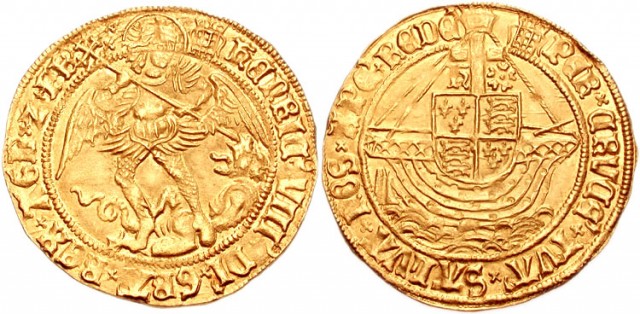
Veröffentlicht am 19th Oct 2009
Geändert am 3rd Nov 2023
Warum Frankreich einen Hahn auf seinen Münzen hat
 Das inoffizielle Nationalsymbol Frankreichs ist der gallische Hahn. Der Ursprung dieses Symbols lässt sich bis in die Antike zurückverfolgen, als die Römer die Region Gallien (auf Latein Gallia) nannten. Cäsar eroberte 58-52 v. Chr. ganz Gallien und machte es zu einer römischen Provinz, die zwar in drei Teile geteilt war, aber immer noch Gallien hieß.
Das inoffizielle Nationalsymbol Frankreichs ist der gallische Hahn. Der Ursprung dieses Symbols lässt sich bis in die Antike zurückverfolgen, als die Römer die Region Gallien (auf Latein Gallia) nannten. Cäsar eroberte 58-52 v. Chr. ganz Gallien und machte es zu einer römischen Provinz, die zwar in drei Teile geteilt war, aber immer noch Gallien hieß.
Die Römer hatten auch ein Wort, Galus, das zur Beschreibung eines Hahns verwendet wurde. Da es gleich klang, dachte jeder, dass Gallien (ausgesprochen mit „a“, nicht mit „o“) von Galus stammte.
Im 6. Jahrhundert n. Chr. kam ein germanisches Volk namens Franken und eroberte die römische Provinz. Sie waren die Elite der neuen Nation und gaben dem Ort, über den sie herrschten, ihren Namen. Aber der Hahn war immer noch ein Symbol dieses Landes.
Im 16. Jahrhundert assoziierten immer mehr Menschen diesen Namen mit dem alten Gallien. Und er wurde zu einem inoffiziellen Symbol. Die Französische Revolution verband dieses Symbol mit den alten Galliern, dem Volk, während die Franken als Adelige galten. Der Hahn war von nun an das offizielle Symbol der Republik Frankreich mit der weiblichen Personifizierung von Marianne.
Der Hahn wurde 1898, während der 3. Republik, als passend für die neue 20-Franc-Goldmünze erachtet. Er wurde 1898 von Jules-Clément Chaplain in seltenen Probeprägungen entworfen und 1899 ausgegeben. Er ersetzte „Der Engel“ und wurde bis 1914 mit dem Rand DIEU PROTÉGÉ LA FRANCE oder LIBERTE EGALITE FRATERNITE hergestellt.

Es wurde auch für die 10-Franc-Münze verwendet. Die Hahnmünze war eine der beliebtesten in ganz Europa. Der französische Franc war damals die wichtigste Währung in Europa. Die Produktion dieser Münzen wurde 1914 eingestellt, als der Erste Weltkrieg begann.
Die Bevölkerung wurde aufgefordert, Goldmünzen für die Kriegsanstrengungen zu spenden und auf einem der beliebtesten Propagandaplakate ist zu sehen: Ein Hahn auf einer Goldmünze gerät in Bewegung und greift in Panik einen deutschen Soldaten an.
Gefallen Ihnen unsere Blogs? Melden Sie sich für E-Mail-Benachrichtigungen an
Durchsuchen Sie unsere französischen Münzen
Suche nach Coin Encyclopedia
In Verbindung stehende Artikel
In den alten Inka-Zivilisationen wurden Gold, Silber und Schätze jenseits Ihrer kühnsten Träume gefunden. Leider wurden im Laufe der Zeit viele der Schätze gestohlen und weit über die Welt transportiert. Wissen Sie, wo all die geplünderten Inka
13th Apr 2018
In welche Anlagemünzen sollten Sie investieren, wenn Sie reine 99,9 % Silber- oder Goldmünzen möchten, und welche Kaufstrategie sollte ich verfolgen, um in Anlagemünzen, Barren oder Rundmünzen zu investieren?
11th Apr 2018
Neue Artikel
Large Cents sind Ein-Cent-Kupfermünzen, die von 1793 bis 1857 geprägt wurden und zu den ersten offiziellen US-Münzen gehörten. Zu den bekanntesten Münzen zählen Kranz- und Kettencents. Erfahren Sie mehr über die Arten, den Wert und die Geschichte der Large Cents!
11th Jul 2025
Hard-Times-Token sind inoffizielle Münzen, die während der Wirtschaftskrise der 1830er Jahre von privaten US-Unternehmen geprägt wurden. Entdecken Sie hier die Geschichte, die rebellischen Designs und den Wert der Hard-Times-Token!
18th Jun 2025
Präsidentendollar sind US-Münzen mit dem Bild aller verstorbenen Präsidenten, die zwischen 2007 und 2020 ausgegeben wurden. Entdecken Sie in diesem Leitfaden Hintergrund, Details und wertvolle Varianten des Präsidentendollars.
5th Jun 2025
Artikelkategorien
Collection of articles providing lots of useful information on coins through the ages.
30 Artikel


